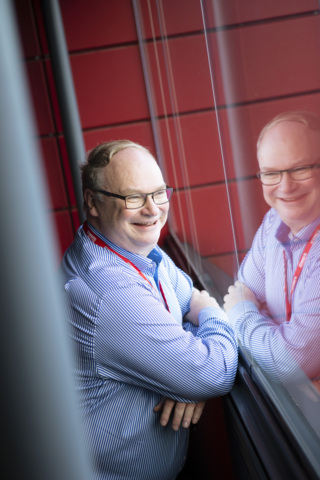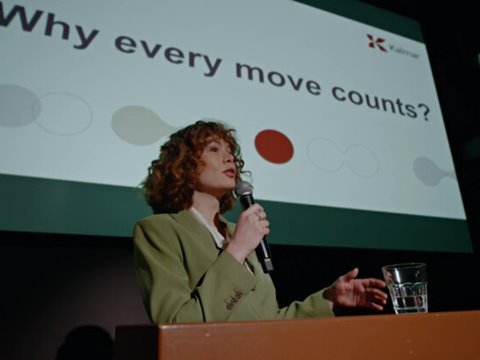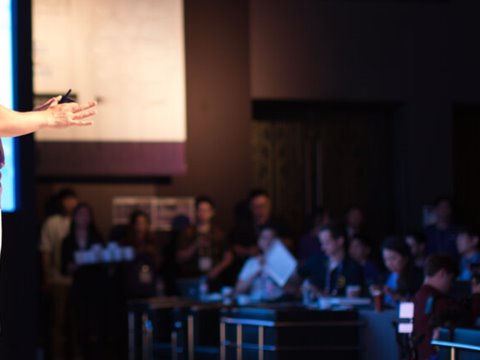People tracking enhances safety in terminal operations
Kalmar is conducting extensive research and development around people tracking, a technology that is being tried out at the company's Technology and Competence Centre in Tampere. How will people tracking help improve the safety and productivity of automated operations at container terminals?
Automation removes people from container yards, but people are always needed on-site for tasks such as maintenance work and exception handling. People are also present at container yards in mixed traffic situations. People tracking is the next step in improving the safety of automated operations. It is a system that provides real-time visibility of the movements of people and equipment so that control room operators and automated systems can ensure the safety of people in the terminal.
"The idea of people tracking has grown from camera-based security systems, but it is now used with a much wider scope," says Pekka Yli-Paunu, Director, Research, Kalmar. "From the perspective of both security and occupational safety, terminals need to have real-time visibility on the location of people in the yard. This is especially relevant for operations that require a combination of automated and manual tasks, such as loading and unloading containers in multimodal terminals. Even if the yard cranes are automated, there will still be people in the yard opening twistlocks and carrying out various maintenance tasks, so there has to be a way to accomplish this safely without causing too many issues for production."
Industrial solutions are subject to standards and regulations that define the safety requirements for systems that involve mixed-mode operation between people and automated equipment. "Any solution that we create needs to conform to these standards, so this has been one of our key areas in research work," Yli-Paunu notes.
Kalmar is currently developing a prototype of people tracking system at the company's Technology and Competence Centre in Tampere, Finland. The solution is based on lightweight location tags that are attached to workers' helmets or safety vests. In addition to the tag, the system uses a mobile phone to assist in determining the location and enable two-way communication with the control room of the terminal.
"There are a ton of possibilities with this approach," says Yli-Paunu. "Over the last couple of years, there has been a lot of interest from terminal operators for this kind of solution, but so far the challenge has been the lack of safety certification for existing systems. This is something we are working on and I expect that we should have a workable, certified system ready for customer use in the relatively near future. Our goal is to evaluate and demonstrate the solution first in our own test yard and gather as much experience and feedback as possible."

Location services create new opportunities
Kalmar is working with multiple partners in developing the people tracking solution, and has been evaluating the full range of available positioning technologies. Pekka Yli-Paunu notes that each alternative system has its unique benefits and compromises.
"For example, ultra-wideband radio is good for reliable location of multiple tags or devices, but the costs are higher than with Bluetooth-based solutions. However, there are a lot of options already on the market. Some companies even offer wearable watch-style personal tracking devices that can raise an alarm if they detect that the user is entering the wrong area or is lying down for an abnormally long time. The tracking devices can also be used by the users themselves for sending an alarm if needed."
With recent advances in location technology, the underlying sensor technology is typically no longer the constraining factor for successful adoption of real-time location services. Yli-Paunu notes that sometimes the largest obstacles may not be technical, but related to human behaviour.
Reliable way of tracking real-time movement of people also opens up possibilities for integration with other systems
"If a safety system is based on having a tag on workers' helmets or vests, it's obviously crucial that they are actually wearing them. Unfortunately, this is not always a given, even though almost all terminals have mandatory requirements for safety equipment on site. It is possible to detect with a machine vision solution whether people entering the terminal gate are wearing the required equipment. So here, too, new technology can provide an efficient, cost-effective way of improving workplace safety."
Having a reliable way of tracking the real-time movement of people in a terminal also opens up possibilities for integration with other systems such as guest management and access control. "Interfacing with these systems is an important part of these systems," says Yli-Paunu. "Once we know where the terminal operator needs the location data, we can provide a lot of additional value."
Safe mixed-mode operations
People tracking can bring safety and security benefits for all types of terminals, but the greatest and most immediate advantages are in enabling the safe coexistence of people and automated container handling equipment. Without a reliable and accurate way to track the movement of people in the terminal yard, automated equipment needs to be parked outside the big designated area before people are able to access the area safely for maintenance work or other tasks. This results in lost time and equipment downtime, especially at intermodal terminals that feature very long rail yards.
"People tracking does also work with manual operations, though in that case the main purpose of the system will be to alert the crane or straddle carrier operator of potentially dangerous situations," notes Pekka Yli-Paunu. "However, an advantage of implementing people tracking in manual operations is that since the system is a warning feature, it does not require as complex safety functions as in automated systems."
In addition to personal locating tags and mobile devices, people tracking solutions can utilise sensor and positioning data from a wide range of other systems. "For example, existing security camera installations can be adapted for this purpose," says Yli-Paunu. "We have also been conducting some research with our university partners on whether mobile phone cameras could be put to use for feature recognition and positioning in container terminals."
Smart area control
Being able to locate people at automated container terminals is essential for both site security and occupational safety. "The technology has now almost matured enough that costs and reliability are at a level that makes it soon possible to build these solutions by combining different types of sensor data," says Pekka Yli-Paunu. "When combined with smart mobile devices, we can also enable applications where employees can use their mobile devices to request access to specific areas of the terminal, and supervisors are able to grant this access for the required time window while maintaining full visibility on where their staff is."
Yli-Paunu expects that operators will be quick to embrace the possibilities of people tracking at terminals. "The technology is already there, so the main work will be in completing the required safety certifications for this system. The benefits are indisputable, so we expect this will be something that will generate a lot of interest in the industry."
Related articles
Subscribe and receive updates in your email
Tilaa julkaisujamme













